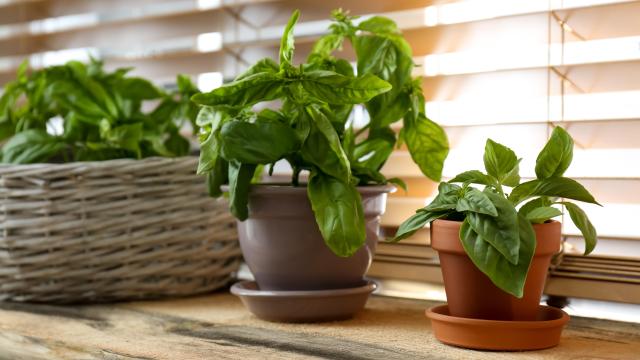Houseplants can be finicky. That’s because when they’re growing in a pot, they don’t get the same interaction with other species or the same type of soil as outdoor plants. Try as we might, we just can’t quite mimic the environment plants have outside. But there are some things we can do to ease the stress of the transition from outdoors to inside, and keep them thriving all season long.
How to prep your plants to move them indoors
To get started, gather up these materials:
- Hose
- Spray bottle
- Stiff bristle brush
- Gentle soap
- Fresh potting soil
- A pair of shears
- Rubbing alcohol
- A large tub
- Gardening gloves
You might also opt to use a soil Ph test kit if you aren’t sure how to fertilize your container plants.
Next, begin readying your plants for transition by pruning out dead or damaged parts. This will help them to adjust to a new environment and hopefully send up new shoots. Use clean shears, wiping the blades down with rubbing alcohol between plants to avoid accidentally transferring any diseases the plants might have. This is also a good time to pick any debris out of the topsoil of the container.
Give the containers themselves a good scrub, making sure that any outdoor material is removed. You can use a mild soap and water to wash the outsides of the container as long as you’re careful not to inundate the plant with detergent. Use the brush to scrub any stubborn spots and then rinse the outside of the container thoroughly.
How to rid the plants of any bugs
The next step is to try and remove outdoor bugs from your indoor plants. Since the indoor environment doesn’t have natural enemies to pests like aphids, bringing an infestation inside, away from natural predators like lady bugs could have disastrous results. To get pests out of the soil, soak your containers with drainage holes in a large tub filled with room temperature water. Make sure that the container is completely submerged for at least a half hour, forcing any soil dwelling insects to the surface. Skim off debris and any bugs from the surface of the water before removing from the tub.
Next, use a spray bottle or a hose (depending on the size and strength of the plant) to spray off any insects like aphids. Some gardeners will use neem oil or soapy water to kill bugs on the leaves, but a gentle swipe with a cotton ball will often do the trick and is less harmful to the plant. If you find that you have a major infestation, you should isolate that plant and treat it for the specific pest you find before bringing it into the house.
This is also a good time to top off the soil or add fertiliser, if needed. You can use a Ph test kit to determine if the soil is balanced. Make sure to adjust the Ph for your specific type of plant to avoid fertiliser shock. If you’re not sure of the needs of your particular houseplant, you can usually get information from your local university gardening extension.
Transition plants indoors slowly
Once your plants have been thoroughly debugged, soaked, and fertilised, you might choose a method similar to hardening off seedlings. If you live in a climate where the change of seasons brings chilly nights and warmer days, or where some days might be OK for plants outdoors while others aren’t, you can opt to bring plants in on cooler days and in the evening while allowing them to soak up some sun during the warmer times.
Once it’s too cold for your plants to vacation on the porch, make sure to choose a spot indoors where they will get a similar amount of light as when they were outside. If you need to, you can move them slowly to lower light areas, making sure they still get some sunlight. Helping the plants to transition slowly to a lower light environment will allow them to adjust. This will help them reroute any nutrients needed and replenish their roots in the soil.

Leave a Reply
You must be logged in to post a comment.